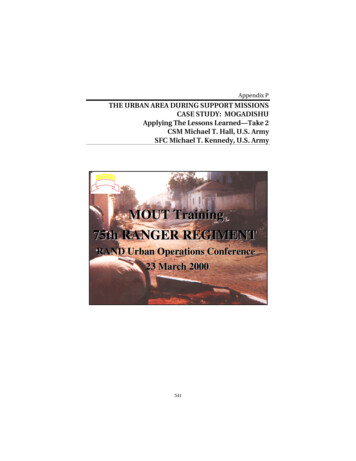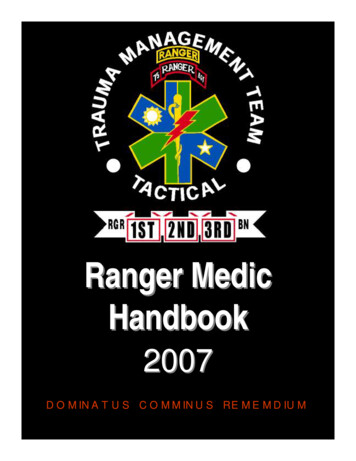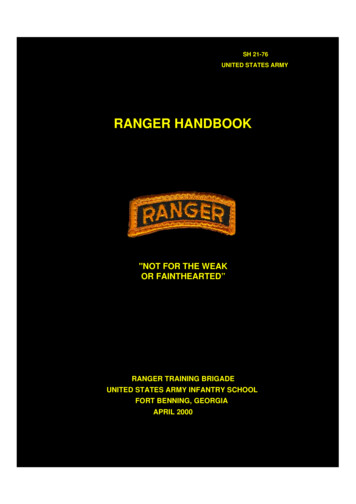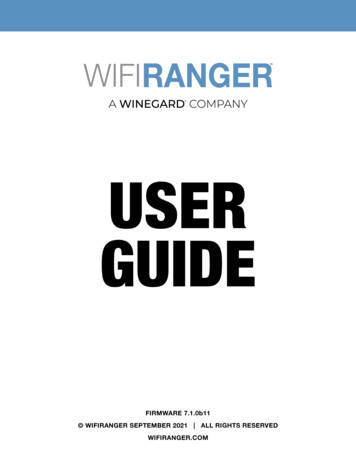
Transcription
Appendix PTHE URBAN AREA DURING SUPPORT MISSIONSCASE STUDY: MOGADISHUApplying The Lessons Learned—Take 2CSM Michael T. Hall, U.S. ArmySFC Michael T. Kennedy, U.S. ArmyMOUT Training75th RANGER REGIMENTRAND Urban Operations Conference23 March 2000541
542 Capital Preservation: Preparing for Urban Operations in the 21st CenturyAGENDA TrainingFocus Equipment/Skills Collective LessonsTrainingLearned
Appendix P: CSM Michael T. Hall and SFC Michael T. Kennedy 543“ our most probable combatsituation—physically grueling,lethal operations encounteredin a night, MOUTenvironment”Regimental Training GuidanceWe know that things that are of real value are in urban areas. Thearmy spends the majority of its time training in a “wooded environment.” We believe that this is training to fight the last war, not thenext one. Hence, the majority of our training is focused on urbanareas. We train as we expect to fight.
544 Capital Preservation: Preparing for Urban Operations in the 21st CenturyMissionPlan and conduct joint specialmilitary operations in supportof U.S. policy and objectives.Who We AreLight InfantryHow We FightArmy FIELD MANUAL 7-8The Infantry Platoon and SquadThis is our mission statement. It is really no different from any otherunit in the military. It is very broad, which can present problems aswe try to figure out what to focus on with our limited assets, the mostlimiting asset being time. We will present how we have attacked thatproblem during the course of this brief.We are many things to many people, but basically we are lightinfantry. We do the things that infantry has always done. For thatreason we believe this brief is applicable to all units in the U.S. military, not just us. We do have some unique capabilities, but at squad,platoon, and company level there is not much difference between usand other units. We do conduct special military operations, but howwe fight is based on standard army doctrine. Field Manual 7-8, TheInfantry Platoon and Squad, is our bible.
Appendix P: CSM Michael T. Hall and SFC Michael T. Kennedy 545Training Priorities REGIMENT– Train the battlestaff on staff METL BATTALION– Maintain a “trained”( “T”) status on “Perform AirborneAssault on a Defended Airfield” COMPANY– In the infrared (IR) Spectrum, on Urban Terrain,maintain a “T” Status on Perform Raid PLATOON/SQUAD– In the IR Spectrum, on Urban Terrain, maintain a“T” Status on: Battle Drill (BD) #1, “Platoon Attack”;BD #2, “React to Contact”; BD #6, “EnterBuilding/Clear Room”; BD #8, “Conduct Breach of aMined Wired Obstacle”We have decided that with the myriad of possible missions out there,there is no way we could be good at all of them, especially since weare on an 18-hour string to go into combat. Therefore, we havecommitted ourselves to being good at a few basic tasks that we feelwe could use as the basis for any combat mission. We are convincedthat no matter what mission we are given, even on very short notice,we can be successful at it because we feel these basic tasks will coverany combat situation we could face.
546 Capital Preservation: Preparing for Urban Operations in the 21st CenturyThe Big Four Training Priorities(The Basics)Physical FitnessMarksmanshipMedical TrainingBattle DrillsWe believe there are four basic areas that a unit needs to master inorder to survive and be successful in combat.Unless we have mastered these four, we won’t do anything else. Mastery of these four skills allows us to execute any mission successfully.
Appendix P: CSM Michael T. Hall and SFC Michael T. Kennedy 547Physical Fitness Sustain footmarch program- 10 Miles Weekly- 20 Miles Quarterly Combat -focused PT.Formal manual.- Bn-level MTTs- 90 minutes per day- New methods, techniques, equipment Combatives- Master the 13 core moves- WeeklyWe know combat, especially in urban areas, will be exhausting.Studies have proven that the better physical shape you are in, the lessmental exhaustion you will suffer. Mental exhaustion has proven tobe a significant factor in urban combat.We believe that combat-focused physical training (PT) is one part oftraining how we will fight. We invested three weeks in a programthat involved a squad leader per platoon and a first sergeant perbattalion working under the supervision of the army physical fitnessschool. They developed a program that more closely mirrors thephysical activities of combat. This was followed by battalion andcompany level leader training. The results have been rewarding:fewer injuries, better physical condition, and more success executingcombat tasks.We don’t really know if we will have to footmarch long distances incombat; we do know that a sustained foot march program is a testedmethod to build true endurance in combat soldiers.
548 Capital Preservation: Preparing for Urban Operations in the 21st CenturyThe other area in our physical fitness system is our combatives program that we will discuss a little later.
Appendix P: CSM Michael T. Hall and SFC Michael T. Kennedy 549Medical Training Individual- Every Ranger is a combat life saver- Battalion sustainment t raining- Regimental-wide standard Ranger EMTs- One EMT-basic per squad- Semi-annual course Ranger Medics- EMT-P/SOMTC- Live tissue training ATLS Ranger units- Casualty play at all training- Mass casualty exercises- Realism (moulage, etc )Two facts about combat, especially urban: we know people will beinjured and wounded and that there are not enough medics. Ourratio is one medic to every 48 soldiers. In order to address this wehave implemented a four tier medical system. The first tier: everyranger is a trained combat lifesaver in accordance with (IAW) thearmy standard plus several additional tasks. We maintain this capability with battalion and company level programs run bimonthly. Weare able to maintain a 90 percent currency rate. The second tier:every squad/section has an EMT-basic certified and current soldier.We maintain this by running semiannual courses. The third tier isthe 91B medic at platoon and company level. These medics maintain an EMT-paramedic level of training. This is maintained throughinternal battalion programs and training at the special operationsmedical training course. The fourth tier is advanced trauma life support with our battalion surgeons and physician’s assistants. Casualtyplay is incorporated into every training event in order to exercise thecapabilities in a realistic environment. It’s a big investment, but onethat will certainly pay off in combat!
550 Capital Preservation: Preparing for Urban Operations in the 21st Century“There are two kinds of people on the battlefield:Marksmen and Targets” Marksmanship vs. Qualification–PMI–Step by Step Process The Four Part Program–Qualify Day–Qualify Night–Close QuartersMarksmanship (CQM)–Combat (Stress) FireThat quote sums up combat and the importance of marksmanship.We realized that the standard army qualification standards did notadequately prepare our soldiers for combat. We also realized thatthe qualification system for developing marksmanship was misleading and did not require soldiers to get better. We broke our marksmanship training and qualification down to the very basics andstarted over again. We discovered, rediscovered is more like it, thatwe could get a lot better if we put our time and effort into preliminarymarksmanship training without ammo. The information is in theFMs and it really works. The biggest key to success was implementation of weekly dry fire training. Another key was to follow the FMsand train with a step by step method, not moving on to the next stepuntil the standard for the previous step was met: zero, grouping,known distance slow fire, known distance timed fire, practice qualification, and then qualification.This system seems very time consuming, but it is actually a muchquicker way to success. Our marksmanship program has four parts.A soldier must qualify during the day IAW army standards. He must
Appendix P: CSM Michael T. Hall and SFC Michael T. Kennedy 551also qualify at night using the day standards. He must then qualifyon our close quarters marksmanship table and combat fire lanes,both of which will be discussed later.
552 Capital Preservation: Preparing for Urban Operations in the 21st CenturyBattle Drills Focus on the Basics– Dry fire Individual movement techniquesTeam and squad fire and movementTAPE drillsMagazine/belt changesCrew drillRates and distribution of fire controlImmediate and remedial action drills Attack, React to Contact, Mined/WiredObstacle, Enter and Clear a BuildingWe are convinced that if our squads and platoons can fight and winwe can accomplish any mission. For this reason, our focus is onsmall unit drills, battle drills.It is easy to maintain readiness levels for battle drills. It’s the individual tasks that go into them that need constant attention. We haveattacked this by executing these tasks in a dry fire mode on a weeklybasis, concentrating on those shown here. By maintaining these weget much more out of our collective training and use the limited assets of ranges, ammo, and training time much more efficiently.Retraining time is rarely available because of resources; the typicalresponse is that an event is usually after action reviewed (AAR’d) andthe unit walks away with “stuff to work on.” That really turns intomaking the same mistake the next time it is executed. Our approachhas all but eliminated that. We are walking away trained by the timewe do the culminating event of live firing at night.The Army FM 7-8 actually has eight battle drills. We know that wecannot maintain a trained status on all eight. By the time you get
Appendix P: CSM Michael T. Hall and SFC Michael T. Kennedy 553around to #8, the unit is no longer proficient in tasks 1–4. We cannotafford the building block method due to our being on an 18-hourstring. We feel that if we can execute these four, everything is a simple reaction to a situation that is easily executed. The one thing incommon with all battle drills is squad fire and movement. If youcan’t do that, you can’t do anything. If your squads can do that, youcan do anything. These are all executed in an urban environment.
554 Capital Preservation: Preparing for Urban Operations in the 21st CenturyRanger Equipment Every Ranger rifleman trains and fights with: Night vision goggles (AN-PVS 7/1 4) Squad communication system Ranger body armor, gloves, ballistic goggles,knee/elbow/shin pads RACK (load carrying system). Wate r, ammo,medical, breaching Medical plus up M4 carbine/M203/M249/M240 with rail systemw/M68 and AN-PEQ-2 laser w/IR illuminator,gun lightThis is our standard fighting uniform that we use in all environments,leaning towards fighting in an urban environment. In combat, youwill not have a chance to go back to the barracks and change this outfor that because the situation changed. For that reason we have developed this system.
Appendix P: CSM Michael T. Hall and SFC Michael T. Kennedy 555Individual Close Quarter Skills Close Quarter Marksmanship–RTC 350-1-2 Combatives Brazilian Jiu Jitsu Urban movement techniques Combat (Stress) fireBombs, artillery, long range fires, and the like do a lot of killing on thebattlefield. The individual rifleman, squad, or platoon has little control over these. Somewhere between about zero and fifty meters, asoldier does have control regarding whether he lives or dies. Webelieve this program gives our soldiers the best chance to live. Theclose fight is a gunfight, just like the Old West.There will never be a time in the near future where the urban fightwon’t have the possibility of being up close and personal. Army FM21-150, Combatives, is a wonderful document. The problem is one offocus and time. Maintaining the skills that are described in the FM isimpossible. The Gracie techniques (see page 14 of FM) are simple tolearn, maintain, and the chances of injury are minimal.Standard army rifle ranges do a poor job of preparing soldiers to killthe enemy. They do not train him to shoot in the many situations hewill face in combat, especially urban combat. We have developedtraining methods that better prepare soldiers for the situations in
556 Capital Preservation: Preparing for Urban Operations in the 21st Centurywhich they will find themselves. We call it combat fire, AKA “stressshoots.”
Appendix P: CSM Michael T. Hall and SFC Michael T. Kennedy 557CQM—350-1-2 Standards Conducted quarterly (25m range) Reflexive firing training Target discrimination Day/night qualification w/wo protective mask Shotgun application Automatic fireIn the close fight, and the urban fight is mostly a close fight for theinfantry, who shoots the fastest and most accurately lives. The otherdies. We have developed a training program to address this. We callit close quarters marksmanship. The standards are contained in ourMOUT training circular and apply to all individual weapons.
558 Capital Preservation: Preparing for Urban Operations in the 21st CenturyCombatives Gracie techniquesDone weeklyOnly 13 core movesBuilds confidence and aggressivenessQualified instructorsCompetitionsPrideInvolves everyoneAs mentioned earlier, the technique of combatives we use is a formof jiu-jitsu named after the world champion Gracie brothers. Combatives training is conducted once a week IAW our training circularto maintain skills. We only maintain 13 core moves because we havedetermined that is all we can retain. What our combatives programgives our ranger more than anything else is confidence and aggressiveness. When the smallest or newest man in the company who hasnever played contact sports or been in a fight in his life can best thebiggest man, he feels pretty good about himself and feels confidentthat he can beat any enemy. We don’t teach knife fighting, rifle drills,or caving in a man’s skull with an e-tool. There are just too manythings to teach and not enough time to teach them. But we believethe confidence and will to win this program builds are the mostimportant factors. Each battalion, company, and platoon maintainsmaster trainers who are directly trained by the Gracies themselves orby personnel trained as instructors by the Gracies. This validates theprogram.
Appendix P: CSM Michael T. Hall and SFC Michael T. Kennedy 559We hold regular regimental-through-squad competitions to ensureall understand the importance of the program and to build esprit decorps. The program builds self-esteem, and this attitude rolls overinto other combat tasks. Combat is man on man. It doesn’t matterwho you are. This program has no rank.
560 Capital Preservation: Preparing for Urban Operations in the 21st CenturyUrban Movement TechniquesCombat (Stress) Fire Validity, Reliability, Simplicity Assess, refine, improve our combat marksmanship(train as we fight) Closely resemble combat conditions Refine equipment we will fight with Incorporates: Stresses (mental and physical)All static firing positions (standing, kneeling, prone)Moving and shootingOff-handShooting over, under, and around obstaclesThe culmination of our marksmanship training program is the combat (stress) fire event. This puts together all of a soldier’s marksmanship skills and runs him through a course similar to what he wouldface in urban combat. The fundamentals underlying any such eventare validity, reliability, and simplicity. It is designed to assess, refine,and improve combat marksmanship. The event closely resemblesthe combat conditions to be expected on the battlefield. It is alwaysdone with the soldier’s full combat load. These events have taught ushow our equipment must be modified and how our marksmanshiptechniques must be altered for maximum effectiveness and“comfort.” There is no “standard course.” Leaders will set up eventsbased on resources available and the level of training of their men.As long as it incorporates the elements shown here, it is considered astandard.
Appendix P: CSM Michael T. Hall and SFC Michael T. Kennedy 561Progressive Breaching Mechanical tools/TTP Ballistic Shotgun Explosive close proximitybreachingThere is no doubt that there will be obstacles on the urban battlefield, and none will be a “standard American-made” door. Theseobstacles can kill timing, momentum, and soldiers if they cannot bereduced quickly and efficiently. The method we use is called progressive breaching. Before getting to the point that must bebreached, the leader must make an assessment of what he is going todo and then prepare. Bullying your way there and then getting“stuck” is exactly what the enemy wants. Assessment and preparedness are the keys to success. Being fully prepared to “ratchet it up”must also be part of the plan. We have three main categories ofbreaching. The first is mechanical, everything from kicking in thedoor to using special tools. Each squad carries one set of tools aspart of its standard equipment. The prying tool is a 24” Haligan toolcommon to fire departments. The striking tool is the eight poundshort handle sledge. We have developed detailed TTPs for allmechanical breaching methods. This is something that must betrained. It isn’t like they show in the movies.
562 Capital Preservation: Preparing for Urban Operations in the 21st CenturyThe second category is ballistic breaching using a Remington 870short shotgun with a special breaching round to defeat lockingmechanisms. Each squad carries one shotgun. The 3rd category isexplosive, using close proximity charges. We use one standardcharge that fits in a cargo pocket. It will defeat any locking or combination of locking systems up to medium strength metal doors. Thereis no fragmentation danger and the blast overpressure is smallenough to allow you to be within a few feet of the door when it blows.
Appendix P: CSM Michael T. Hall and SFC Michael T. Kennedy 563Distracter Devices Critical to saving lives Non-Lethal (Friend or Foe) Offensive Grenades Flashbangs Simulators Smoke (Signaling and CS) Lethal Fragmentation Grenades 40mm AT Weapons ExplosiveBefore entering a room or building with known or suspected hostilepersonnel, it is critical to use some kind of distracter device. If not,the enemy will always have the advantage. You can equate the importance of a distracter device to the importance of suppressive fire.It is critical and must be standard procedure. Without it, soldiers willdie unnecessarily. There are basically two categories: lethal andnonlethal. Nonlethal are the best choice because they have the samedesired effect and there is no danger to friendlies.
564 Capital Preservation: Preparing for Urban Operations in the 21st CenturyHigh Explosives(Battalion and Company Assets) Critical to success Small arms fire, ineffective/inefficient for killing orsuppression Must know and understand weapons andmunitions target effects Critical to footholds. “Breaching” not toblow holes, but to kill. Door is best placeto enter.There is a tremendous amount of good cover capable of protecting asoldier from small arms fire available in an urban environment. Somuch so that very little killing will be done with small arms fireexchanged between well-trained and matched foes. The use ofmunitions more powerful than ball ammunition will be critical tosuccess in an urban fight. High explosive ammo is the answer, butnot in the conventional sense. Long-range heavy artillery and airborne fire support are not as effective as in a wooded environment.They cannot provide the close-in support needed by the squad,platoon, or company. High explosive ammo is a scarce resource atsmall unit level because of its weight and bulk, so it is critical thatevery shot counts. To attack this problem, we conduct events to trainour leaders on the true effects of the weapons and munitions at theirdisposal. The use of high explosive is critical to establishingfootholds and the initial breach. Small units will not have anythingavailable to them for creating a “new” hole for assault.
Appendix P: CSM Michael T. Hall and SFC Michael T. Kennedy 565Simmunitions Not “paintball” Changed our TTPs Makes training real– Closest thing to two-way live fire Opens up many more trainingopportunities/sites– Can “live fire” anywhereSimmunitions are 9mm plastic rounds that are fired out of a specialupper receiver. They can be used force-on-force when certain protective measures are used. Simmunitions is not a paintball game.You know when you are hit and you tend to act as if it is a live bullet.The use of simmunitions has changed the way we fight in an urbanenvironment. It disproved many accepted techniques and validatednew techniques like nothing else available short of actual combat.Using SIM is the closest thing to a two-way live fire. There is nocheating and the threat of pain trains soldiers to do the right thing.The paint is washable. The rounds can be used in just about anyfacility. That means training can be conducted in a variety of buildings and structures that was not available in the past. We have neverbeen told to not come back to any facility where we have employedsimmunitions.
566 Capital Preservation: Preparing for Urban Operations in the 21st CenturyCollective Training Company Level and Higher is critical Individuals, Teams, and Squads are OK Platoon, Company, and Battalion coordination isbiggest weakness in supporting squads Ratio: 1 Squad, 3 Platoon, 1 Company In the hard fight, footholds/entry gained only throughusing same procedures as breaching a mined, wiredobstacleThe conventional wisdom on urban training is that most of the available training time should be given to the squad because the urbanfight is a squad fight. That is true. The problem is that the squadneeds a tremendous amount of support to be able to close with anddestroy the enemy. We are convinced that our individuals, teams,and squads need comparatively little train-up to get to standard. Thedifficulty is putting it all together so that platoon leaders, companycommanders, and battalion commanders can effectively control andfocus their assets to support that one breaching squad. This lessonhad to be relearned in WWII, Korea, Vietnam, Panama, and Somalia.The urban fight is very much a squad fight, but it requires morecommand and control than any other contingency. It must be coordinated such that a whole company, and perhaps a battalion, will beconcentrating on nothing more than getting one squad across astreet.We think a good ratio of training time is one block of time to a squad,three at platoon, and one at company. It should be realized thesquads are training throughout all three blocks.
Appendix P: CSM Michael T. Hall and SFC Michael T. Kennedy 567In the hard fight, the same TTPs used to breach a mined and wiredobstacle will be needed to get that initial foothold/entry point. Aplatoon (-) in support will not work on a determined enemy. We alsoregularly conduct leader TEWTs downtown and in garrison areas inorder to work this task.
568 Capital Preservation: Preparing for Urban Operations in the 21st CenturySurgical Fire Support Lethal/Nonlethal Assets Fixed Wing Rotary Wing Organic Mortars Urban ROE Munitions Selection TGT/Observer IDThe very nature of an urban environment limits conventional firesupport, especially during the close fight. Nonlethal methods suchas jamming enemy communications in order to disrupt his command and control will help. PSYOP and CA operations will be criticalto the fight but may only have limited effectiveness due to demographic characteristics and the sophistication of the enemy. Mortarsare of some use because of their high angle of fire, quick responsiveness, and ability to fix the enemy. Fixed wing aircraft such as the AC130 can be very effective because they can get to targets from the top,but they themselves are vulnerable targets. Structures will usually bean impediment to attack aircraft’s ability to provide precisionsupport. The rules of engagement will rarely be unrestricted enoughto use our largest munitions, those necessary to totally reducestructures. Even if buildings are destroyed, they are usually turnedinto strong points and propaganda vehicles for the enemy. Munitions will have to be selected carefully and observed fires will be thenormal requirement.
Appendix P: CSM Michael T. Hall and SFC Michael T. Kennedy 569“The phrase that pays” Shoot till the enemy goes down Never move faster than you can accuratelyengage the target Fight the enemy, not the plan It’s a three-dimensional fight Combat patience, be prepared or be dead Stacking is for firewood, the 3-second rule It takes two We kill with HEWe have some simple rules to live by in any fight. They are especiallyapplicable to the urban fight. Shoot until the enemy goes down. Thedouble tap (firing two shots) is not a guarantee. We train using controlled pairs in as many multiples as needed. Speed is relative; youcannot outrun a bullet. We live by the principle that there is only onething between you and the enemy: your weapon. The enemy doesn’tget our OPORD; he doesn’t play fair; we only own half of the battlefield at best. Always be prepared for the unexpected; know andunderstand the commander’s intent. The tendency is to focus forward on your next move or where we know or think the enemy is.The urban fight is 360 degrees and forces must be allocated againstthis. The common tendency in an urban fight is to move fast, maintain momentum, and get across the next street or into the nextbuilding or room. Speed can definitely kill in an urban environment.You must be prepared for your next action. Speed and surprise comefrom preparedness.The stack is nothing more than a bunch, which we all know getspeople killed and reduces the combat effectiveness of a unit down to
570 Capital Preservation: Preparing for Urban Operations in the 21st Centuryone man. The team stack is used when entering a room or building,but it is something that is flowed into and never lasts more thanthree seconds. Fighting a platoon in an urban environment willseverely task the platoon leader and the platoon sergeant. The platoon leader must concentrate on his entire area of responsibility, that360 degrees. The platoon sergeant helps with the internal coordination between squads. The same applies at company level with theexecutive officer assuming the platoon sergeant role. Everyone has aspecific mission in the fight. Their conventional roles must wait untilconsolidation and reorganization. High explosives are what we useas the primary killer.
Appendix P: CSM Michael T. Hall and SFC Michael T. Kennedy 571Shortcomings in Technology Decentralized use ofUAV Detect, Deliver, Assess Organic Short Range Counter-mortarcapability Aerial Observer/ FAC(A) AP/AT Mine Awareness Mobility ArmoredGround Mobility System Force Protection Necessity for groundMEDEVAC platform Enclosed space,shoulder-firedAT/Breaching WeaponThese are some lessons learned from recent fighting around theworld that are of great help in the urban fight. UAVs can be a greatclose support asset in assisting our developing situational awareness.A lightweight mortar counter radar capability that is capable ofworking in an urban environment is needed for the light infantry.Aerial observation greatly enhances the commander’s ability to seedeep into his battlefield. Booby traps and mines are employed morethan ever in an urban environment as an enemy force multiplier.Mobility, especially armored mobility, is important for re-supply andmedical evacuation.
572 Capital Preservation: Preparing for Urban Operations in the 21st CenturyConclusion—75th RangerRegiment MOUT Brief Individual training Standardization of firing tables (2 5m) Introduction of stress shooting Equipment standardization Collective training Simmunitions improves force on force tosqd/plt level Increased training frequencyConclusion—75th RangerRegiment MOUT Brief Collective training ( cont)– Company and higher (STX)– Integration of heavy weapons(MG, AT, mortars, attack helos, AC-130)
Appendix P: CSM Michael T. Hall and SFC Michael T. Kennedy 573Bottom LineThe principles of fire and movementapply in the urban environment just asthey do in the woods. The cover andconcealment is different, the enemy thesame, the bullets just as deadly.
–Close Quarters Marksmanship (CQM) –Combat (Stress) Fire That quote sums up combat and the importance of marksmanship. We realized that the standard army qualification standards did not adequately prepare our soldiers for combat. We also realized that the qual










